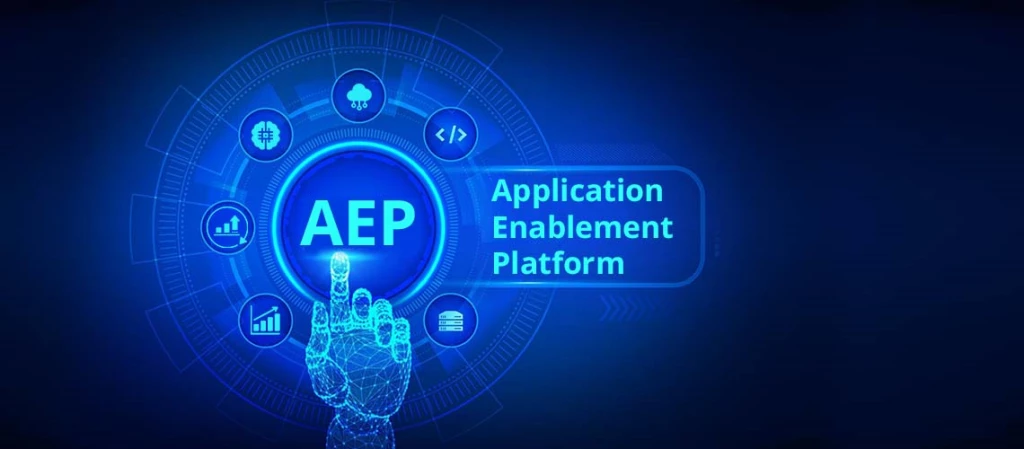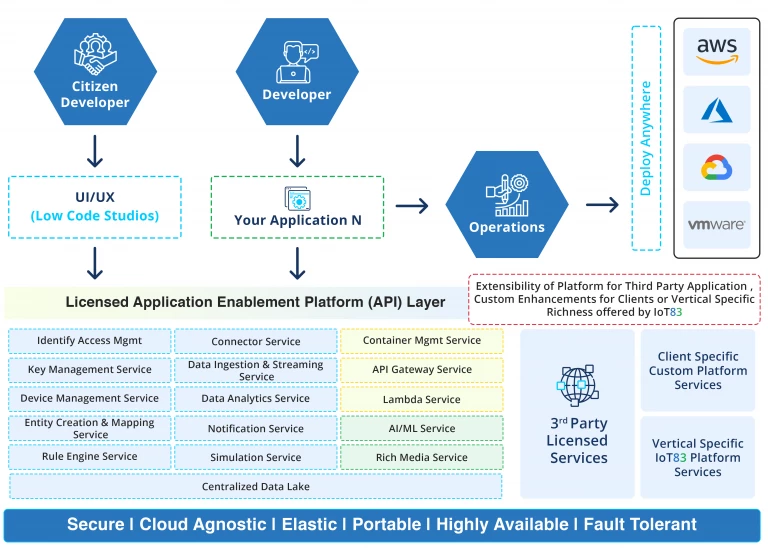
An application enablement platform transforms the cost, risk, and time to market bespoke application creation and deployment. It provides an entirely scalable, secure & flexible platform “Out of the box,” along with intuitive no-code, low-code, and custom-code workflows to quickly build virtually anything.
This blog will review some of the key considerations while building & launching IoT solutions on application enablement platforms (AEPs). These key considerations are scalability, elasticity, portability, the total cost of ownership, time-to-market, and code ownership.
Scalability – Scalable core so that it can handle diverse data types from millions of devices
Scalability is the key to handling the explosive growth in the Internet of Things (IoT). IoT applications should support the ever-increasing number of connected devices, users, application features, data, analytics and visualization capabilities, etc., without compromising the quality of performance.
A robust IoT application today must be able to scale to support millions of such diverse devices, users, or tools efficiently and cost-effectively as the usage of the application changes, new devices or data flows get added, or requirements grow.
While designing a bespoke IoT application, some of these points must be considered
- Implications in case the volume, velocity, or variety of data increases by a factor of ten or even a hundred?
- What kind of interactive queries are likely to be executed by new end users or intelligent devices?
- What will happen if the sizes of databases keep increasing enormously every day?
- What is the nature of real-time requirements the application has?
- How does the application cater to deadline-driven processing tasks, and what might happen if such events are not performed when the number of devices suddenly increases or if data collection’s frequency or nature changes?
An excellent bespoke IoT application must be able to address the above scalability requirements to manage the constantly growing IoT ecosystem.
Elasticity – Capable of handling smaller as well as larger deployments on the same core with the capability to step up or step down
Simply put, the elasticity of an IoT network is its ability to expand or reduce its capacity quickly without hindering or jeopardizing its stability, performance, security, governance, or compliance protocols. Considering the dynamic nature of an IoT network, IoT device provisioning or de-provisioning is one of the first features of a good IoT application.
In IoT architecture, the number of sensors can be vast, and the associated number of transactions can be even more significant. Setting up auto-scale for the resource is not necessarily a one-time or flexible approach. With time, many sensors and devices either go redundant or dysfunctional. Hence, there is no need for such devices to be in the IoT network, and these must be de-provisioned. Similarly, the number of users keeps changing. And such users, too, need to be de-provisioned.
Even the same holds are suitable for data storage. Not all the data that is generated needs to be stored. Therefore, the IoT network must follow a modify-as-use approach to maintain a strategic distance from over or under subscribing. Hence, a good IoT platform or an application enablement platform must offer the desired elasticity and handle smaller and larger deployments on the same core with the capability to step up or step down.
Portability or Cloud Agnosticism: Building on the cloud and deploying anywhere – public cloud, private cloud, or edge
The usage of IoT platforms and cloud services is almost indispensable today. And there are too many options available. Although all the IoT platforms offer more or less similar possibilities for creating, deploying, and managing an IoT infrastructure, sometimes, organizations have to move to a different cloud for various reasons, such as the need for a new feature or cost optimization.
The more an organization invests in agnostic architecture upfront, the less it will cost them to switch cloud services. However, at the same time, a more complex and agnostic design will decrease productivity and slow down your delivery process.

Source: cloudcomputing-news.net
Cost of Ownership – Building an IoT App on AEP costs one-third compared to building it through a traditional approach
An IoT platform’s build vs. buy process is not the same as deciding upon software services to buy. There is much more complexity and investment involved in IoT platform decisions than any build vs. buy decision.
With an IoT AEP an organization is not just choosing a single technology. Instead, they invest in a stack (ranging from software, connectivity, data management, device management, security, etc.) of tightly integrated technologies dependent on one another to work correctly.
Purchasing a ready-made IoT platform saves an organization time and money. We are aware that the total cost of ownership (TCO) is a financial estimate of all the direct and indirect costs of a product or system. For an IoT solution, a TCO estimate includes the initial implementation costs and all costs incurred by the asset during its service life. This may consist of devices, data storage, data transformation, software, hardware, labor, repairs, security auditing, monitoring, and support. The long-term TCO of building an IoT app from scratch is significantly higher than using an AEP to build an app. When developing a platform, the enterprise will assume all of those costs; however, it will have a much lower TCO when licensing a platform. The best part is that most of the investment in a subscription model falls under operational expense and a marginal amount falls under the capital expenditure.
Rapid Application Development
Other vital considerations while building an application on AEP are the time to market or faster application turnaround and code ownership. It is given that developing an IoT app on AEP has to have a much quicker time to market because an AEP offers a standard plug-and-play middleware interface and nothing needs to be created from scratch. All that is required is customizations based on the process flow of a specific business.
Flex83 AEP Vertical Agnostic Rich Service Layer to Build & Deploy Bespoke Applications

Lastly, the most essential part of a platform should be that it offers code ownership of whatever is developed. The code should be the customer’s intellectual property (IP), and he should have access from the get-go.
Discover more about the capabilities and value that the Flex83 Rapid Application Development Platform can deliver to your business.
